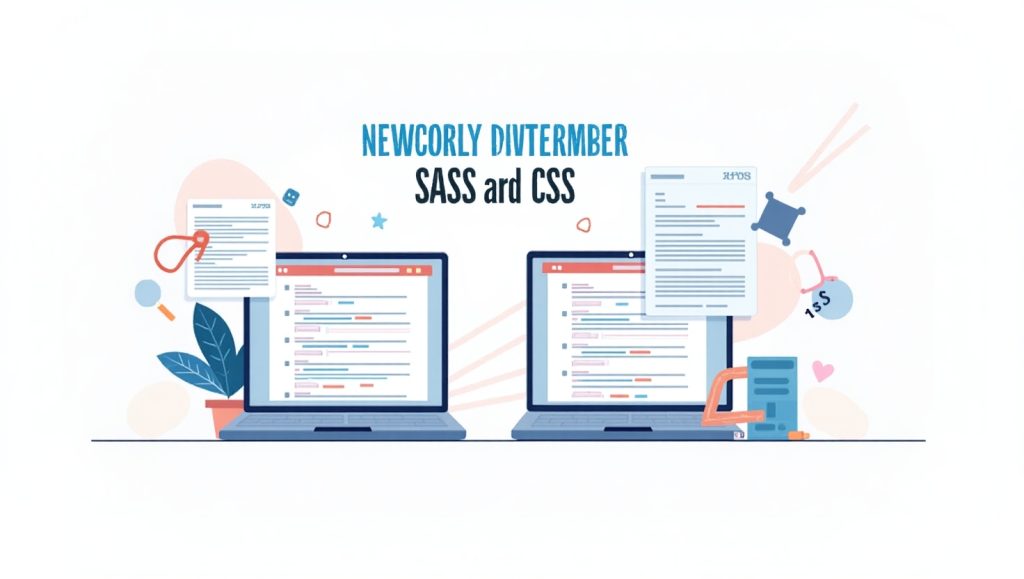
In today and age of front-end development, Sass and Less are considered to be the easiest tools for the web designer and web developer. These allow for extension of CSS standard capabilities so that it would adhere to rules of styles more effectively concerning maintainability, modularity, and scalability. When it comes to making the choice between Sass and Less, however, things can get quite confusing.
While both preprocessors replicate similar functions through variables, mixins, nesting, and functions, the true difference lies in the handling of these functions in relation to the workflow. These differences might stand as the basis for your decision whether working on a mini project or large industrial web project.
Now let us take a look at these differences, how they would play a role in different developer environments, and ultimately why this difference would mean more than you think.
Feature Comparison Between Sass and Less
Although both Sass and Less came into being to simplify the CSS manner of working, they have different philosophies of design and syntactical concerns. Sass, which stands for Syntactically Awesome Stylesheets, first appeared in 2006 and has received constant updates to add support for two syntax types: the original indented syntax (.sass) and the more CSS-like SCSS (.scss). Less, on the other hand, from the start has gone for a syntax that strongly resembles CSS, which is more or less reassuring to beginners.
The very first conspicuous difference is the variable declaration. Sass uses the $ sign to declare a variable, while Less uses @. This alone is not completely paralyzing but is bound to have some association with a developer’s level of comfort with that style language itself.
The other major thing that makes a distinct difference is the implementation. Sass is implemented in Dart, the most up-to-date implementation with better performance, while it used to be implemented in Ruby. Another thing is that Less is implemented in JavaScript, so it is well integrated within browser/ Node.js environments, which is beneficial for Gulp/ Webpack task runners, as this means you can conveniently build Sass scripts with existing JavaScript tools.
Then there are complex control directives Sass provides @if, @for, @each, and @while for logical-heavy stylesheets. Less offers logical operations as well but not as profoundly and powerfully as Sass. Thus, when we are talking about projects with complex styles and conditional theming, Sass is the one of choice.
If you’re implementing a late-state CSS workflow or developing a Node.js-based project, Less could be a worthwhile option for simplistic-to-midway projects.
Syntax and Learning Curve
When it comes to syntax selection, developers usually choose based on what they are familiar with and what is easy for them to learn. For example, Sass with SCSS syntax is more flexible and readable for people who already know CSS, since it allows semicolons, braces, and indentation that match with CSS perfectly.
Less is much closer to CSS and, therefore, much more friendly to a beginner. Stepping into the world of preprocessors, it might feel a bit more comfortable using Less. Its use of @ for variables is similar to other programming languages, for example, PHP, making it intuitive for some developers.
Sass, however, maintains both the older indented syntax and SCSS to serve different individuals’ varied preference. This becomes an added advantage especially in cases where one is working in a team with different skill levels or stylistic predilection.
Tooling and Integration in Workflows

What tooling support is immense in choosing a CSS preprocessor? Sass and Less are well integrated into modern development environments, but there are some subtle differences that are worth being mentioned.
Sass is widely supported by tools such as Webpack, Gulp, Grunt, and the latest frameworks such as Next.js and Angular. Many UI libraries and frameworks are transitioning to Sass for their style needs, suggesting industry preference, such as Bootstrap.
On the contrary, Less still maintains a cult following that supports its uptake in older projects and ecosystems like Ant Design, which continues to rely on it as well. Less works off JavaScript, so it is easy to integrate into frontend JavaScript-heavy projects without extra dependencies.
Community and Ecosystem Support
Therefore, when selecting an instrument for incorporation into the daily workflow, one must consider community and ecosystem support. In this case, Sass clearly has more leverage. Sass’s GitHub repository is also a lot more current, and there exist far more numbers of tutorials, frameworks, and themes developed within Sass.
This means that for the most part, there are good manuals to refer to, answers on Stack Overflow, as well as a greater assortment of plugins and libraries able to provide native support for Sass itself. This is incredibly important when modeling large-scale enterprise applications, which will usually present their own sets of unique styling problems.
Less’s community is small and shows fewer recent updates. That does not mean it cannot work-it does. But in terms of future-proofing, Sass offers more long-term support and development.
In general, organizations that have frequent collaboration or hiring efforts would really benefit in reducing time for onboarding and troubleshooting with a well-supported preprocessor like Sass.
Performance, Maintenance, and Scalability
The new Dart implementation compiles the Sass faster, making it great for large projects. Though, complex Nested styles or complex imports, Less would slow down, albeit not so much for small projects.
Sass, on the other hand, gives considerable timeliness on maintenance. It has modules, partials, and the latest @use rule that conquers previous @import; Sass does modularization and maintenance quite well. Scalable lots can benefit from this in web projects.
Less does allow file imports and styles that are modular, but their system is neither strict nor up-to-date as that of Sass’s @use and @forward. It is a yard with which guard controls of entrapment of variables.
Sass, for example, has an architecture that one might require to manage styles without side-effects for an application that has multiple themes and manages a large team of developers.
It is the scalability that makes Sass a good choice for agencies, freelancers, or teams developing projects that keep growing. This could mean growth in revenue from something as simple as a custom WordPress development workflow or a new scalable SaaS platform.
Real-World Use Cases and Final Thoughts
If what you’re doing is a project that requires maintainability, logic-oriented styles, and robust community backing, Sass is the way to go. It’s designed for today’s workflows, backed by top frameworks, and always improving.
Conversely, Less is a good option if you are operating in an ecosystem with heavy use of JavaScript or working on legacy code. It’s lighter, simpler to learn, and works well with the tooling that is already there.
All that being said, industry trends are decidedly in favor of Sass. Large CSS frameworks and design systems are making the transition to Sass, and with Dart Sass now being the norm, it’s more performance-friendly than ever.
In the end, both tools are capable. The decision should hinge on your project’s specific needs, your team’s comfort level, and the ecosystem you’re operating in.
For SEO-aware web developers, applying preprocessors such as Sass results in cleaner and neater stylesheets, which contribute to faster page load speeds, an important SEO factor indirectly.
Conclusion
The decision between Sass and Less is a matter of grasping the requirements of your project and delivering on the needs of your development process. Both preprocessors augment CSS with dynamic capabilities such as variables, mixins, and nesting, but Sass has more to provide in terms of advanced features, greater tooling integration, and forward-thinking architecture.
Sass, with its contemporary syntax and expanding base, is usually the first choice for developers looking to create scalable, maintainable codebases—particularly in projects that involve frameworks such as Bootstrap or tools such as Webpack. It excels in complicated environments where modular architecture and logic-dense styling are needed.
Less, however, is still a tried-and-true choice for existing projects based within JavaScript ecosystems or older codebases. Its simplicity and easy-to-understand CSS-like syntax are a good starting point for novices or groups working on older platforms.
Ultimately, the choice isn’t which one is superior, but which one is best for you. For developers building responsive WordPress web design, or teams responsible for multi-theme sites, Sass provides the high-level tooling and modularity that can dramatically enhance development speed and code quality.